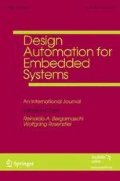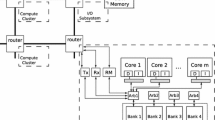Abstract
Mixed-criticality systems are promoted in industry due to their potential to reduce size, weight, power, and cost. Nonetheless, deploying mixed-criticality applications on commercial multi-core platforms remains a highly challenging problem. To name a few reasons: (i) Industrial mixed-criticality applications are usually complex reactive applications, which cannot be specified by traditional, e.g., dataflow-based, models of computation. Appropriate mixed-criticality models of computation built upon Vestal’s assumptions are missing; (ii) Scheduling such applications on multicores with shared resources, such as memory buses, requires that any timing interference among applications of different criticality is bounded in order to guarantee—the necessary for certification—temporal isolation and to enable incremental design; (iii) The implementation of isolation-preserving mixed-criticality schedulers is itself subject to certification. Hence, it needs to be not only efficient, but also provably correct. This paper proposes, for the first time, a complete design flow covering all aspects from specification, using a novel mixed-criticality aware model of computation (DOL-Critical), to correct-by-construction implementation, using the principle ‘what you verify is what you generate’ which is based on a novel variant of task automata. We demonstrate the applicability of our design flow with an industrial avionic test case on the state-of-the-art Kalray MPPA®-256.















Similar content being viewed by others
Notes
References
Abdellatif T, Combaz J, Sifakis J (2010) Model-based implementation of real-time applications. In: EMSOFT ’10
AbsInt (2015) aiT worst-case execution time analyzers. https://www.absint.com/ait/
Alur R, Dill DL (1990) Automata for modeling real-time systems. In: Paterson M (ed) Proceedings of the 17th international colloquium on automata, languages and programming (ICALP), LNCS, vol 443, Springer, pp 322–335
Amnell T, Fersman E, Mokrushin L, Pettersson P, Yi W (2002) TIMES—a tool for modelling and implementation of embedded systems. In: Proceedings of tools and algorithms for the construction and analysis of systems, Springer, pp 460–464
Anderson J, Baruah S, Brandenburg B (2009) Multicore operating-system support for mixed criticality. In: Workshop on mixed criticality: roadmap to evolving UAV certification
ARINC. ARINC 653-1 Avionics application software standard interface. Technical report
Barhorst J, Belote T, Binns P, Hoffman J, Paunicka J, Sarathy P, Stanfill J, Stuart D, Urzi R (2009) White paper: a research agenda for mixed-criticality systems, CPS Week 2009. http://www.cse.wustl.edu/~cdgill/CPSWEEK09_MCAR
Baruah S, Chattopadhyay B, Li H, Shin I (2014) Mixed-criticality scheduling on multiprocessors. Real Time Syst 50:142–177
Bourgos P, Basu A, Bozga M, Bensalem S, Sifakis J, Huang K (2011) Rigorous system level modeling and analysis of mixed HW/SW systems. In: Proceedings of international conference on formal methods and models for codesign, MEMOCODE 2011, pp 11–20
Burns A, Baruah S (2013) Towards a more practical model for mixed criticality systems. Workshop on mixed criticality, pp 1–6
Burns A, Davis R (2015) Mixed criticality systems: a review. https://www-users.cs.york.ac.uk/burns/review.pdf
Burns A, Fleming T, Baruah S (2015) Cyclic executives, multi-core platforms and mixed criticality applications. In: Euromicro conference on real-time systems (ECRTS), pp 3–12
Calandrino J, Leontyev H, Block A, Devi U, Anderson J (2006) LITMUS RT: a testbed for empirically comparing real-time multiprocessor schedulers. In: RTSS, pp 111–126
de Dinechin B D, van Amstel D, Poulhiès M, Lager G (2014) Time-critical computing on a single-chip massively parallel processor. In: DATE’14, EDAA
de Niz D, Phan LTX (2014) Partitioned scheduling of multi-modal mixed-criticality real-time systems on multiprocessor platforms. In: RTAS, pp 111–122
DO-178C. RTCA/DO-178C, Software considerations in airborne systems and equipment certification (2012)
DOL-Critical (2014) Distributed operation layer for mixed-criticality applications. http://www.tik.ee.ethz.ch/~certainty/dolc.html
Durrieu G, Faugère M, Girbal S, G. Pérez D, Pagetti C, Puffitsch W (2014) Predictable flight management system implementation on a multicore processor. In: ERTSS’14
Easwaran A (2013) Demand-based scheduling of mixed-criticality sporadic tasks on one processor. In: RTSS’13
Ekberg P, Yi W (2012) Bounding and shaping the demand of mixed-criticality sporadic tasks. In: ECRTS’12
Fersman E, Krcál P, Pettersson P, Yi W (2007) Task automata: schedulability, decidability and undecidability. Inf Comput 205(8):1149–1172
Flodin J, Lampka K, Yi W (2014) Dynamic budgeting for settling DRAM contention of co-running hard and soft real-time tasks. In: 2014 9th IEEE international symposium on Industrial embedded systems (SIES), pp 151–159
Giannopoulou G, Lampka K, Stoimenov N, Thiele L (2012) Timed model checking with abstractions: towards worst-case response time analysis in resource-sharing manycore systems. In: EMSOFT’12
Giannopoulou G, Stoimenov N, Huang P, Thiele L (2013) Scheduling of mixed-criticality applications on resource-sharing multicore systems. In: EMSOFT’13
Giannopoulou G, Stoimenov N, Huang P, Thiele L, de Dinechin B (2015) Mixed-criticality scheduling on cluster-based manycores with shared communication and storage resources. Real Time Syst 51:1–51
Goossens S, Akesson B, Goossens K (2013) Conservative open-page policy for mixed time-criticality memory controllers. In: DATE’13
Hansson A, Goossens K, Bekooij M, Huisken J (2009) CompSoC: a template for composable and predictable multi-processor system on chips. ACM Trans Des Autom Electron Syst (TODAES) 14(1):2
Hassan M, Patel H, Pellizzoni R (2015) A framework for scheduling DRAM memory accesses for multi-core mixed-time critical systems. In: RTAS, pp 307–316
Herman J, Kenna C, Mollison M, Anderson J, Johnson D (2012) RTOS support for multicore mixed-criticality systems. In: RTAS, pp 197–208
Huang H-M, Gill C, Lu C (2014) Implementation and evaluation of mixed-criticality scheduling approaches for sporadic tasks. ACM Trans Embed Comput Syst 13(4s):126:1–126:25
Huang K, Haid W, Bacivarov I, Keller M, Thiele L (2012) Embedding formal performance analysis into the design cycle of MPSoCs for real-time streaming applications. ACM Trans Embed Comput Syst (TECS) 11(1):8
Huang P, Giannopoulou G, Ahmed R, Bartolini DB, Thiele L (2015) An isolation scheduling model for multicores. In: RTSS, San Antonio, TX, USA
Huang P, Giannopoulou G, Stoimenov N, Thiele L (2014) Service adaptions for mixed-criticality systems. In: ASP-DAC’14
ISO 26262 (2011) Road vehicles—functional safety. https://www.iso.org/standard/43464.html
Kahn G (1974) The semantics of a simple language for parallel programming. In: Proceedings of IFIP congress on information processing, vol 74, pp 471–475
Kienhuis B, Deprettere E, Vissers K, van der Wolf P (1997) An approach for quantitative analysis of application-specific dataflow architectures. In: Internatioanl coference on application-specific systems, architectures and processors (ASAP), pp 338–349
Kim N, Ward BC, Chisholm M, Fu CY et al (2016) Attacking the one-out-of-m multicore problem by combining hardware management with mixed-criticality provisioning. In: RTAS
Kirkpatrick S, Gelatt CD, Vecchi MP (1983) Optimization by simulated annealing. Science 220:671–680
Kotaba O, Nowotsch J, Paulitsch M, Petters SM, Theiling H (2014) Multicore in real-time systems–temporal isolation challenges due to shared resources. In: Workshop on industry-driven approaches for cost-effective certification of safety-critical, mixed-criticality systems
Lee J, Phan K-M, Gu X, Lee J, Easwaran A, Shin I, Lee I (2014) MC-fluid: fluid model-based mixed-criticality scheduling on multiprocessors. In: RTSS, pp 41–52
Li H, Baruah S (2010) Load-based schedulability analysis of certifiable mixed-criticality systems. In: International conference on embedded software, EMSOFT’10
Melpignano D, Benini L, Flamand E, Jego B, Lepley T, Haugou G, Clermidy F, Dutoit D (2012) Platform 2012, a many-core computing accelerator for embedded SoCs: performance evaluation of visual analytics applications. In: DAC’12
Michael RG, David SJ (1979) Computers and intractability: a guide to the theory of NP-completeness. WH Freeman & Co., San Francisco
Mollison MS, Erickson JP, Anderson JH, Baruah SK, Scoredos JA (2010) Mixed-criticality real-time scheduling for multicore systems. In: International conference on computer and information technology, CIT’10, IEEE, pp 1864–1871
Paolieri M, Quiñones E, Cazorla FJ, Bernat G, Valero M (2009) Hardware support for WCET analysis of hard real-time multicore systems. In: ISCA, pp 57–68
Pathan R (2012) Schedulability analysis of mixed-criticality systems on multiprocessors. In: ECRTS’12
Pellizzoni R, Bui BD, Caccamo M, Sha L (2008) Coscheduling of CPU and I/O transactions in COTS-based embedded systems. In: RTSS’08
Perrotin M, Conquet E, Dissaux P, Tsiodras T, Hugues J (2010) The TASTE Toolset: turning human designed heterogeneous systems into computer built homogeneous software. In: Proceedings of embedded real-time software and systems conference
Poplavko P, Bourgos P, Socci D, Bensalem S, Bozga M (2015) Multicore code generation for time-critical applications (Tool). http://www-verimag.imag.fr/Multicore-Time-Critical-Code,470.html
Poplavko P, Socci D, Bourgos P, Bensalem S, Bozga M (2015) Models for deterministic execution of real-time multiprocessor applications. In: DATE
Reineke J, Liu I, Patel HD, Kim S, Lee EA (2011) PRET DRAM controller: bank privatization for predictability and temporal isolation. In: Proceedings of the seventh IEEE/ACM/IFIP international conference on Hardware/software codesign and system synthesis, pp 99–108
Santy F, George L, Thierry P, Goossens J (2012) Relaxing mixed-criticality scheduling strictness for task sets scheduled with FP. In: ECRTS, IEEE, pp 155–165
Sha L, Caccamo M, Mancuso R, Kim J-E, Yoon M-K, Pellizzoni R, Yun H et al (2014) Single core equivalent virtual machines for hard real-time computing on multicore processors. Technical report, University of Illinois at Urbana-Champaign
Sigrist L, Giannopoulou G, Huang P, Gomez A, Thiele L (2015) Mixed-criticality runtime mechanisms and evaluation on multicores. In: RTAS’15
Socci D, Poplavko P, Bensalem S, Bozga M (2013) Modeling mixed-critical systems in real-time BIP. In: ReTiMiCs’2013
Socci D, Poplavko P, Bourgos P, Bensalem S, Bozga M (2015) A timed-automata based middleware for time-critical multicore applications. In: Extended version of SEUS’15 workshop paper. Report TR-2015-12, Verimag
Sriram S, Bhattacharyya S (2009) Embedded multiprocessors: scheduling and synchronization. Signal processing and communications, 2nd edn. Taylor & Francis, Abington
Su H, Zhu D (2013) An elastic mixed-criticality task model and its scheduling algorithm. In: DATE, pp 147–152
Tamas-Selicean D, Pop P (2011) Design optimization of mixed-criticality real-time applications on cost-constrained partitioned architectures. In: RTSS’11
Thiele L, Bacivarov I, Haid W, Huang K (2007) Mapping applications to tiled multiprocessor embedded systems. In: ACSD’07
Thiele L, Chakraborty S, Naedele M (2000) Real-time calculus for scheduling hard real-time systems. In: ISCAS
Tobuschat S, Axer P, Ernst R, Diemer J (2013) IDAMC: a NoC for mixed criticality systems. In: RTCSA, pp 149–156
Triki A, Combaz J, Bensalem S, Sifakis J (2013) Model-based implementation of parallel real-time systems. In: FASE’13, Springer
Vestal S (2007) Preemptive scheduling of multi-criticality systems with varying degrees of execution time assurance. In: RTSS’07
Waez MTB, Dingel J, Rudie K (2013) A survey of timed automata for the development of real-time systems. Comput Sci Rev 9:1–26
Wilhelm R, Grund D, Reineke J, Schlickling M, Pister M, Ferdinand C (2009) Memory hierarchies, pipelines, and buses for future architectures in time-critical embedded systems. IEEE Trans Comput Aid Des Integr Circuits Syst 28(7):966–978
Wu ZP, Krish Y, Pellizzoni R (2013) Worst case analysis of DRAM latency in multi-requestor systems. In: RTSS, pp 372–383
Yan G, Zhu X, Yan R, Li G (2014) Formal throughput and response time analysis of MARTE models. In: Proceedings of formal methods and software engineering, pp 430–445
Yun H, Mancuso R, Wu Z-P, Pellizzoni R (2014) PALLOC: DRAM bank-aware memory allocator for performance isolation on multicore platforms. In: 2014 IEEE 20th, real-time and embedded technology and applications symposium (RTAS), pp 155–166
Yun H, Yao G, Pellizzoni R, Caccamo M, Sha L (2012) Memory access control in multiprocessor for real-time systems with mixed criticality. In: ECRTS’12
Acknowledgements
The research leading to these results has received funding from the European Union Seventh Framework Programme (FP7/2007-2013) under grant agreement number 288175 (CERTAINTY project).
Author information
Authors and Affiliations
Corresponding author
Additional information
Publisher's Note
Springer Nature remains neutral with regard to jurisdictional claims in published maps and institutional affiliations.
Peter Poplavko, Dario Socci and Paraskevas Bourgos—Ex-employees of VERIMAG (“The presented research was performed while working at VERIMAG”).
Rights and permissions
About this article
Cite this article
Giannopoulou, G., Poplavko, P., Socci, D. et al. DOL-BIP-Critical: a tool chain for rigorous design and implementation of mixed-criticality multi-core systems. Des Autom Embed Syst 22, 141–181 (2018). https://doi.org/10.1007/s10617-018-9206-3
Received:
Accepted:
Published:
Issue Date:
DOI: https://doi.org/10.1007/s10617-018-9206-3




